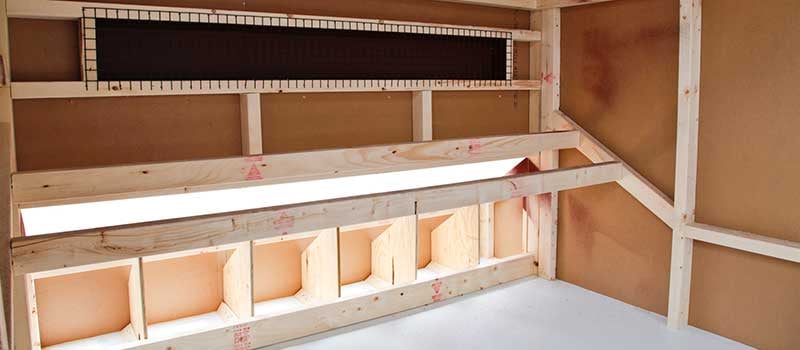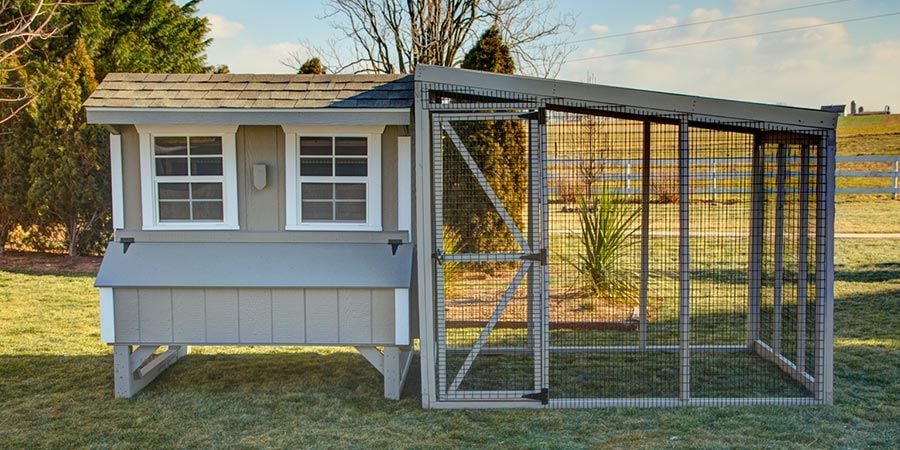Simple Easy Cleaning: Streamlining Maintenance for Your Chicken Coop
by Dakota Storage Buildings, on December 13, 2023

For backyard poultry enthusiasts, maintaining a clean, healthy environment for your flock is paramount. However, the daily grind of coop cleaning can often feel overwhelming. If the upkeep bogs you down, you might consider starting again with a new, easy-to-maintain enclosed chicken coop. Investing in a new chicken coop may initially seem daunting, but it is a proactive step that could redefine your approach to poultry care. With a few tips, you can transform the difficult task of cleaning your coop into a streamlined, efficient process. Here, we will discuss some efficient, easy cleaning practices to ensure your chickens are happy in their homes, laying delicious eggs, and thriving in peak health.
From Coop to Kitchen: Understanding the Health Imperatives of Chicken Coop Cleanliness
Maintaining a clean chicken coop plays a pivotal role in safeguarding both human and animal health, significantly influencing the quality of the poultry products that come from your flock. It is a critical aspect that, unfortunately, can be overshadowed by the complexities and workload involved in upkeep. However, understanding the profound impact of a hygienic living space for your chickens is the first step in appreciating the necessity of this chore.
Let's discuss the health implications for humans, primarily the risk of Salmonella. This bacteria, prevalent in poultry, represents a direct link between the conditions of your chicken coop and the health of those consuming the eggs or handling the birds. Salmonella can easily transfer from chickens to humans through direct contact or even indirectly from the coop environment itself. If the coop is laden with fecal matter and not regularly sanitized, the risk of the bacteria spreading increases exponentially. This concern is not just for those tending to the chickens but extends to anyone consuming the eggs.
In terms of your flock's health, a clean habitat is vital. Chickens are susceptible to various respiratory diseases, and an unclean, poorly ventilated coop can become a breeding ground for pathogens, dust, and ammonia from accumulated droppings, all of which pose severe health risks. These conditions can quickly lead to an array of health problems, from simple eye irritation to life-threatening respiratory infections. Chickens in clean, well-maintained coops are less stressed, exhibit natural behaviors more freely, and are generally more content. This positive effect on their mental health has a direct correlation with their physical health and productivity, impacting egg production, quality, and the immune system's effectiveness.
The cleanliness of the coop also influences the quality of the eggs produced. Eggs in a clean environment have less fecal contamination, reducing the likelihood of bacteria on the shell and inside the egg. This factor is crucial for ensuring the eggs' safety for consumption, particularly if they are not fully cooked, providing peace of mind about the quality of your homegrown produce. Regular cleaning alerts you to any potential issues in the coop, such as pest infestations, mold growth, or structural damages, that could otherwise go unnoticed. These problems, if left unaddressed, could escalate, compromising the coop's safety and comfort and potentially leading to disease outbreaks.
Crafting Your Coop Maintenance Schedule
Maintaining the cleanliness of your enclosed chicken coop is not a one-size-fits-all task. The frequency of your cleaning efforts is influenced by several factors, including the size of your coop, the number of chickens, the type of bedding material used, and even the local climate conditions. Navigating through these variables to establish a routine is essential for creating a sustainable, healthy environment for your flock. Daily attention is crucial. Each day, you should be removing soiled bedding, leftover food, and any broken eggs. This daily upkeep prevents the buildup of harmful bacteria and keeps the coop smelling fresh. Turning over the bedding material can help it last longer, as it freshens the material and helps it dry out more efficiently, preventing issues related to dampness and mold.
A more thorough clean, however, is recommended on a weekly to bi-weekly basis. This involves completely replacing the bedding, removing all the droppings, and examining the coop for any signs of wear, damage, or pest infestations. Doing this regular comprehensive cleaning prevents long-term issues that might arise from neglect, such as the weakening of the coop's structure due to rot or persistent pest problems.
Deep cleaning is an even more intensive process and should be conducted every few months, depending on the coop's condition and the factors mentioned earlier. This step might involve disinfecting the entire coop, addressing any maintenance issues like repairing the structure, and ensuring that the space is not only clean on the surface but also free from any potential health hazards like mites or bacteria. It is also an excellent opportunity to check the security of your coop, reinforcing protection against predators.

Coop Cleaning Methods for Busy Chicken Owners
The task of cleaning your enclosed chicken coop can seem daunting, especially considering the health risks involved if not done thoroughly. However, by following a systematic approach, you can make this chore efficient, effective, and even rewarding. Let’s look at the steps and strategies to not only clean your coop but also maintain its cleanliness, ensuring a safe, hospitable environment for your chickens.
Preparation is Key: Before diving into the cleaning process, proper preparation is crucial. Gather necessary supplies, including gloves, face masks or respirators, scrapers, brushes, a shovel, a bucket, and cleaning solutions (preferably non-toxic). Remember, you are not just protecting the coop but also yourself from inhaling dust and bacteria.
Remove the Chickens: Begin by relocating your chickens to a temporary, safe area. This step ensures their safety, prevents them from being stressed by the cleaning activity, and gives them unobstructed space to work efficiently.
Empty the Coop: Remove all removable items from the coop, including feeders, water containers, and portable perches. These should be cleaned separately with warm, soapy water and allowed to dry completely to prevent mold. Take out all the bedding and any large droppings at this stage, too.
Scraping Off Debris: With the coop empty, it is time to tackle the built-up debris. Using a scraper, shovel, or brush, scrape off any droppings or dirt attached to the floors, walls, and perches. Be thorough, as these areas can harbor parasites or harmful bacteria.
Disinfecting: A thorough disinfection is necessary once the coop is free from debris. Use a non-toxic, chicken-safe disinfectant to clean the interior surfaces. A mixture of vinegar and water can be an effective and natural solution. Pay particular attention to corners, cracks, and crevices where pathogens might be lurking. After disinfecting, rinse the surfaces with water and ensure the coop is entirely dry before reintroducing bedding to prevent mold and mildew.
Rebedding: When reintroducing bedding, consider the material. Layering the floor with a thick layer helps absorb droppings and simplifies future cleanings. Remember, the cleaner and drier the bedding, the less attractive your coop is to pests.
Regular Upkeep: Implement daily touch-up cleanings to maintain the overall cleanliness. This routine involves removing soiled bedding, turning over the remaining bedding to ventilate it, and checking the general state of the coop. Weekly, remove all bedding and follow a lighter version of the steps above. These regular practices dramatically reduce your workload during more intensive, scheduled cleanings.
Innovative Additions: To facilitate easy cleaning, consider modifications like installing removable droppings trays, which can be cleaned separately, or vinyl flooring to make the scraping and disinfecting process smoother. Adding proper ventilation can significantly impact moisture levels and air quality, preventing respiratory issues in your flock and reducing dampness that encourages bacterial growth.
Monitoring for Future Improvements: Post-cleaning, observe your chickens and note any changes in their behavior or health. This monitoring helps you understand the effectiveness of your cleaning routine and any areas needing adjustment. Always look out for innovative methods or products that could streamline the cleaning process further.

Discover the Lasting Quality of Dakota Storage Buildings' Chicken Coops
Not all coops are fashioned equally. If your current setup is faltering, or you are browsing for a new addition, Dakota Storage Buildings proudly presents top-tier chicken coops. Crafted with premium, enduring, and weather-resistant materials, these coops promise longevity and reliable shelter for your prized poultry. Everything from nesting boxes to robust flooring and wall sheathing is designed with the welfare of your chickens in mind. Understanding the nuances of enclosed chicken coops empowers you to select the enclosure that aligns with your home, property size, and chicken count. Easy cleaning and happy chickens can be a delightful reality waiting for you. So, why wait? Shop our stock coops and revolutionize your poultry experience today!

























